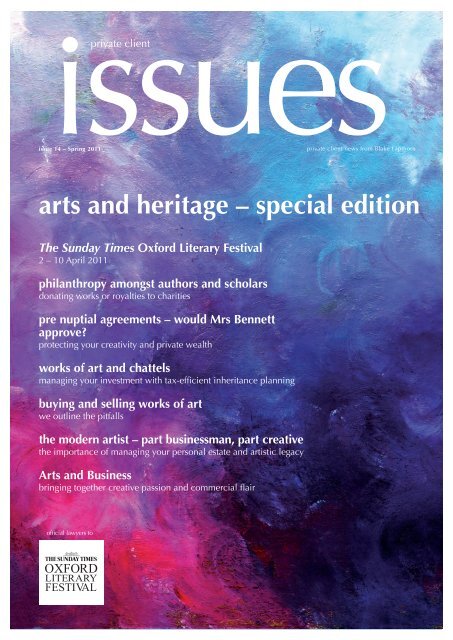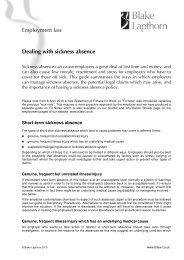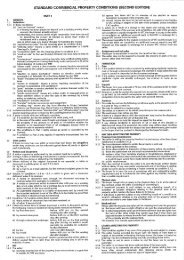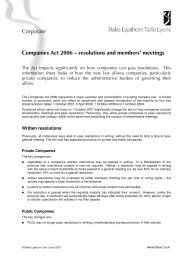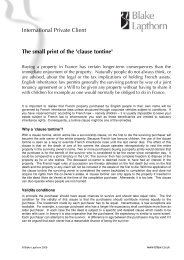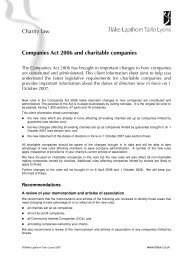Private Client Issues - Blake Lapthorn
Private Client Issues - Blake Lapthorn
Private Client Issues - Blake Lapthorn
Create successful ePaper yourself
Turn your PDF publications into a flip-book with our unique Google optimized e-Paper software.
welcome......to our latest edition of private client issues, which marks ourassociation with The Sunday Times Oxford Literary Festival takingplace from 2-10 April. Attended by world renown writers and publicfigures, this event is an annual literary delight, set in some of thecountry’s finest historic buildings – see below for more details.Arts and heritage are there to be enjoyed by all. With the marketfor antiques as buoyant as ever, no doubt helped along by popularTV shows, many of us are getting involved in buying and sellingantiques. But, it’s important to know how you can protect yourinvestment, so you can enjoy it now and hand it on safely to futuregenerations.For those thinking of embarking upon a new career, maybedeveloping a natural talent for writing or a creative hobby into apersonal enterprise, we offer some tax planning tips for gettingstarted. Whether up-coming talent or established ‘name’, we alsoprovide some important tips as how best to protect your intellectualproperty in the event of a relationship breakdown.And finally, we take a look at Arts and Business, an organisationthat works hard to create new partnerships between commerce andculture.I hope that you find this edition of issues informative and, as always,welcome feedback and ideas for articles that you would like to includein the future. Please email these to: privateclientinfo@bllaw.co.uk.Rachel BrooksHead of <strong>Private</strong> <strong>Client</strong> ServicesThe Sunday Times OxfordLiterary Festival<strong>Blake</strong> <strong>Lapthorn</strong> is pleased to announce that we have been appointed asthe official lawyers to the 2011 Sunday Times Oxford Literary Festival.The Festival, which is sponsored by The Sunday Times and the BBC,will take place from Saturday 2 April to Sunday 10 April 2011 at ChristChurch, Corpus Christi, and Merton College in Oxford.Over 350 writers will flock to the City to discuss affairs literary,political, historical, environmental and culinary for the eight-dayFestival. In 2010, 540 speakers took part in 300 events, with ticketsales breaking all records. Oxford boasted a galaxy of literaryluminaries, including Jung Chang, Douglas Hurd, Philip Pullman, SirRoy Strong, Joanna Trollope, Robert Winston, Richard E Grant, PattiSmith, Dave Eggers, Ruth Rendell, Shirley Williams, Penelope Lively,Colin Dexter, Rose Tremain, <strong>Blake</strong> Morrison, P D James and D J Taylor.Visitors will be able to book to join guided literary walks, lunches anddinner parties with prominent authors. Since 2008, a creative writingcourse has also formed part of the programme.The 2011 programme has been announced, so to keepup with what’s going on, please visit the Festival website atwww.oxfordliteraryfestival.co.uk. As official lawyers to the event,we also have access to a limited number of reduced priced tickets.If you would like to know more, please get in touch with your usualcontact at <strong>Blake</strong> <strong>Lapthorn</strong> to register your interest.It promises to be a great week!For more information on any of the topics raised in this edition of issues, or to see what else is new, why not visit our website at:www/bllaw.co.uk/privateclientnews2 private client issues
issuesbuying and sellingworks of art– what are thepitfalls?by Lara RobsonThe most common problems faced by those buying and selling valuable worksof art and antiques are:• establishing the correct attribution or authenticity, and• ensuring the provenance is accurate and reliable.Here we provide a summary of some of the key issues that are involved indealing with these problems.The correct attribution can make the difference in value of millions of poundsand experts often disagree. What can you do if you suspect that somethingyou have bought or something you have sold has been given the wrongattribution or description?the importance of timeOne of the main difficulties is that often a problem will not be discovered untilmany years after the event. This can result in a potentially legitimate claimbeing time barred.This was demonstrated very clearly in the recent New York case 1 involvingChristies and the “Bella Principessa”, a drawing now attributed to Leonardo daVinci. Christies’ experts had, back in 1998, said it was a 19th century Germandrawing and it sold for under $22,000. Since the attribution to Leonardo daVinci, it is now valued in the region of $100 million. The person who sold thedrawing in 1998 brought a claim against Christies, but it has been dismissedbecause the events happened too long ago.In England and Wales you would usually have six years in which to bring aclaim, but this may vary depending on its nature. If you suspect there is aproblem, you should seek advice promptly.what type of claim might you have?This will vary considerably depending on the particular facts, but a few generalpoints can be made.If you have bought or sold at a general auction house, it is pretty well establishedlaw that the duty of care owed is relatively limited. The leading case in thisarea 2 concerned a provincial auction house that had failed to recognise twopictures that were potentially painted by Stubbs, meaning they would be worththousands, and instead gave them a valuation of just £30-£50. The Court ofAppeal held that the duty owed was to do the job of valuing the paintingshonestly and with due diligence, but as valuing a painting where the artist wasunknown is an uncertain art, then inconsistent or even wrong valuations wouldnot necessarily mean that the auction house or valuer was negligent.There can be circumstances where the auction house’s duty is enhanced.In a recent case against Christies 3 in relation to two vases with a value ofeither around £25,000 or around £2 million, it was agreed by both partiesthat Christies had assumed a greater duty of care to the buyer because shewas a ‘special client’ who was allocated her own expert advisor on whom shewas relying for specialist advice. Here the test was whether Christies, havingcarried out detailed investigations, “had or should have had “a real rather thanfanciful doubt” as to the catalogue description [and the advice provided to theclaimant]”.what about stolen art?Examining the provenance of art or antiquities carefully is important to establishthe attribution and valuation. However it is also critical to ensure that the selleris entitled to sell.In a recent case 4 the court found that despite the fact the paintings in questionhad been sold several times since stolen from their original owner, as thebuyers were unable to demonstrate that they bought the paintings in goodfaith, the original owner was entitled to claim them back.So if you are looking to purchase a painting and there is an unexplained gapin the recent provenance, then it would be prudent to check this out properlyto ensure, as far as possible, that there is no suspicion of theft or uncertaintyaround the ownership. This is sensible as not only is there a risk that if thenecessary checks are not made the purchased item could have to be returned,but offences could also have been committed under the Proceeds of CrimeAct.1 Marchig v Christies No. 10 Civ. 36242 Luxmoore-May and another v Messenger May Baverstock (a firm) [1990] 1 All ER 10673 Thomson v Christie Manson & Woods Ltd and others [2005] EWCA Civ 5554 Kurtha v Marks [2008] EWHC 336 (QB)Lara Robson is a solicitor in our Litigation and Dispute Resolution team in London.Lara can be contacted on 020 7814 5491 or emailed at lara.robson@bllaw.co.uk.private client issues 5


